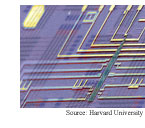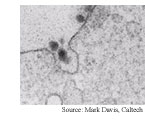
 |
 |
 |
 |


Research Watch Blog
| EMFs and biochemistry |
| February 23, 2011 |
| Evidence is accumulating that electromagnetic fields induce biochemical changes. A study published in the Journal of the American Medical Association shows that cellphone EMFs temporarily boost brain cell metabolism... |
| Nanotech: for good and ill |
| February 22, 2011 |
| A pair of research
papers shows nanotechnology's Jekyll and Hyde nature. |
| Has quantum biology's time come? |
| January 28, 2011 |
| The idea that
quantum processes, particularly entanglement, could play a role in
consciousness has intrigued physicists, philosophers and New Age dreamers
for decades. But the improbability of fragile quantum states surviving
in living beings... |
| As the worm turns — on demand |
| January 24, 2011 |
| We’ve seen remote control rats and remote control cockroaches... |
Papers of Note
Looks like nature picked a good one when she came up with the onion. Fill an onion-like nanoparticle with the right protein, fuse the nanolayers to each other, and you have a vaccine that’s safer than live viruses and more effective than synthetic vaccines.
Interbilayer-crosslinked multilamellar vesicles as synthetic vaccines for potent humoral and cellular immune responses, Nature Materials
Structure networks like an onion, with a tightly connected core and concentric outer layers, and you can make them more secure against attacks.
Onion-like network topology enhances robustness against malicious attacks, Journal of Statistical Mechanics: Theory and Experiment
Stories Elsewhere
Nanotubes protect brain tissue from stroke damage, Chemistry World
(Source: Nature Nanotechnology paper Amine-modified single-walled carbon nanotubes protect neurons from injury in a rat stroke model)
A Dazzling Show Inside a Laser, but a Vacuum of Light Outside, New York Times
Beam Bagged: "Reverse Laser" Functions as Near-Perfect Light Absorber, Scientific American
Physicists Build World’s First Antilaser, Wired
(Source: Science paper Time-Reversed Lasing and Interferometric Control of Absorption)
The First Full-Color Display with Quantum Dots, Technology Review
Connect the Quantum Dots for a Full-Color Image, Nature News
(Source: Nature Photonics paper Full-colour quantum dot displays fabricated by transfer printing)
 The
Smallest Computing Systems Yet, Technology Review
The
Smallest Computing Systems Yet, Technology ReviewMolybdenite transistor is a first, physicsworld.com
Scaled-Down Success: Programmable Logic Tiles Could Form Basis of Nanoprocessors, Scientific American
Harvard Team Makes Programmable Logic from Nanowires, IEEE Spectrum
(Source: Nature paper Programmable nanowire circuits for nanoprocessors)
Atom-Thick Material Shows Electronic Promise, Technology Review
New material for semis said to beat silicon, EE Times
(Source: Nature Nanotechnology paper Single-layer MoS2 transistors)
Features
 Nano
cancer drugs move to the next level: humans
Nano
cancer drugs move to the next level: humansA growing number of cancer therapies packaged in infinitesimal particles are making their way to patients.
Can nanotech beat cancer?
Cancer will always be with us in some form, but the fear and devastation it causes could be history within a generation. We'll have the tiniest of things to thank for it.
View from the High Ground
Email conversations with researchers in high places.
How It Works
Get the nitty-gritty on nanotechnology, biochips, self-assembly, DNA technologies, quantum cryptography, and more.
Buy an ad link |

Blog RSS feed
See our sister publication
Energy Research News
| "In
most areas of science and technology, the origins of new breakthroughs
can still be found in the work of a small number of people -- or even
a single person -- working at their own pace on their own questions,
pursuing things that interest them. " - Jon Kleinberg, Cornell University |
| "Funding,
of course, enables discoveries but does not guarantee they will occur.
Lack of funding can almost certainly guarantee that discoveries will
not be made." - Ronald Arkin, Georgia Institute of Technology |
| "Physics
is to the rest of science what machine tools are to engineering. A
corollary is that science places power in our hands which can be used
for good or ill. Technology has been abused in this way throughout
the ages from gunpowder to atomic bombs." - John Pendry, Imperial College London |
Thanks to Kevin from
GoldBamboo.com
for technical support